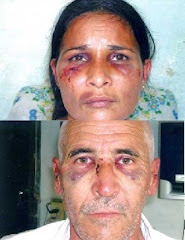In Cuba You Eat What You Can / Iván García
Ivan Garcia, 13 June 2016 — After making the rounds at the farmers'
market and complaining about the paltry assortment of meat, fruits and
vegetables, Mercedes, a seventy-nine-year-old retiree, is standing in
front of a stall selling fresh and smoked pork.
She is buying ten pounds of pork chops for forty pesos a pound and two
kilograms of pale, tasteless ham for thirty pesos. "It is all they had,"
says Mercedes on her way home. "And I am lucky because, thanks to my
daughter who sends me money from the United States, at least I can eat
meat and buy enough vegetables to have two meals a day. Some of the
neighbors on my block don't even have breakfast and only eat once a day."
Every year, the UN Food and Agriculture Organization (FAO) commends Cuba
for meeting its nutritional standards.
But putting together a menu on the island that includes four dishes and
two hot meals a day remains one of the biggest problems — and desires —
facing most Cuban families. In a country where comparative statistics
are hard to come by, measuring nutritional quality is a complex task.
Leonardo, a nutritionist, notes that, "although a family of four needs
four monthly salaries of 600 pesos — in other words, 2,400 pesos — to
buy quality food, there is no famine in Cuba. There are, however,
vulnerable groups and people who suffer from hidden hunger, a term used
by some experts to refer to families who are forced to eat foods with
little nutritional value. And the lower their income, the worse their diet."
According to Leonardo, eating well does not mean eating a lot. "In Cuba
food choices are very limited. Countless Cubans have not eaten fresh
fish, shellfish or beef for years. In spite of price controls, people do
not eat enough fruits and vegetables. Half the population gets its
calories from carbohydrates such as pizza, bread and sweets — what we
call junk food," he observes.
Yolanda, a dietician, notes that "excessive consumption of white bread
and meats cured with high levels of sodium nitrate, which do not meet
the nutritional standards, has led to an increase in hypertension
throughout the country. A large segment of citizenry has gotten used to
lunching on pizza, bread with cold cuts, fried foods and foods with high
levels of saturated fat. The result is that half the Cuban population is
overweight or obese."
Yislén, a burly brunette who sells nylon bags for a peso and sticks of
butter for five pesos outside a bakery in the Havana neighborhood of
Monaco, has hypertension, diabetes and suffers from circulation
problems. "I am a traveling hospital. My diet basically consists of
foods made with flour. Sometimes there is a piece of pork or chicken,
but much more often it is rice and beans, spaghetti and lots of bread
with anything inside."
Low-income families often eat whatever is available or what they can afford.
The nutritionist Leonard advocates "closing state-owned cafes that sell
roast pork sandwiches, that contain more fat than meat, and
fish-flavored breads, that are fish in name only and are made up mainly
of flour and saturated fat. It is the children who pay the highest price
for this dreadful food. They have all-day classes and the only things
their parents can prepare for them to eat at school are omelet
sandwiches, croquettes, hot dogs, soft drinks and sweets."
If you want to have a balanced diet in Cuba, one rich in protein, you
will need at a minimum one-hundred twenty dollars a month, almost five
times the average salary. And even if you have the money, you may not
always be able to find nutritious foods.
"In the hard currency stores, the fish they sell has spent several
months in the freezer. And they sell a lot of canned foods that are not
conducive to a healthy diet," says Yolanda, the dietitian.
For Niurka, a single mother with three children, the ideal situation
would be to have access to healthy foods. "But I work at a pharmacy and
make five-hundred [Cuban] pesos a month," she notes. "That is not enough
to adequately feed my children. It's a porkchop today, a slice of ham
tomorrow and fish croquettes with bread the next day. Lunch and dinner
on Sundays are a little better."
Several foods are on the verge of extinction on the island. Oranges and
mandarins are missing in action. The sugar apple, soursop and chirimoya
are fruits unknown to the youngest among us.
Traditional dishes — rice with okra, stuffed chayote squash and crab
enchiladas — have also been disappearing. And having a bistec de
palomilla (marinated, pan-fried round steak) or grilled snapper for
lunch on Sunday is a luxury out of reach for many people. It cannot be
said that there is hunger in Cuba but neither can it be said that we eat
well
Source: In Cuba You Eat What You Can / Iván García – Translating Cuba -
http://translatingcuba.com/in-cuba-you-eat-what-you-can-ivn-garca/
Subscribe to:
Post Comments (Atom)

No comments:
Post a Comment